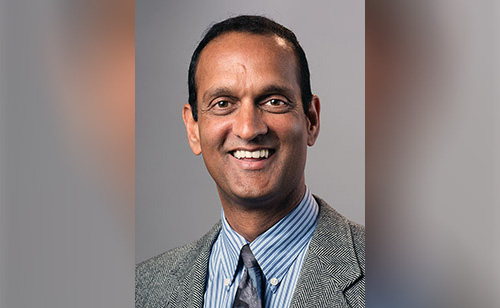An expert and advisory committee member offers expertise and wisdom in the study of traumatic brain injury treatment

Dr. Pradeep Ramanathan, associate professor in the department of communication disorders at Texas State University, is an advisory committee member for Mt. Diablo Adult Education’s On Track Program. Photo courtesy Pradeep Ramanathan
Dr. Pradeep Ramanathan wants to change the way the general public thinks about traumatic brain injuries (TBI), which are typically acquired via vehicular accidents, falls or contact sports. Part of the challenge, he says, is that there’s a common misconception, even among neurosurgeons, that significant recovery is limited to a short timespan.
Ramanathan acknowledges that the most rapid recovery comes in the immediate aftermath of a TBI, but also stressses that tremendous growth is possible for patients years after first suffering their injury.
It’s just one reason he sits on the advisory committee for the On Track Program, part of Mt. Diablo Adult Education’s Adults with Disabilities Program (AWD). The program offers services to adults with TBIs as well as acquired brain injuries (ABI), which are caused by internal bodily factors, like strokes or infections.
“Many doctors think whatever abilities you have after one year, that’s what you’re stuck with for the rest of your life. That’s simply not true.”
Dr. Pradeep Ramanathan, Advisory Committee Member, Mt. Diablo Adult Education’s On Track Program
“Many doctors think that whatever abilities you have after one year, that’s what you’re stuck with for the rest of your life,” says Ramanathan, who is also an associate professor in the department of communication disorders at Texas State University. “That’s simply not true.”
The On Track Program seeks to improve the day-to-day functionality of adults who have suffered TBIs and who face an uphill battle to reclaim cognitive abilities like remembering, reasoning, planning, remaining attentive, problem-solving and interacting with others. It also addresses the discouragement and depression that can often result from TBIs. In a classroom environment that provides social stimulation with peers, students work with faculty to address their specific issues.
“There’s a synergistic effect of those two factors,” Ramanathan says. “When you start seeing improvements, that’s even more motivating.”
As an example of TBIs effects and potential treatments, Ramanathan offers details about a study financed by the Firedoll Foundation, a family-run charitable organization that works with Mt. Diablo to support TBI survivors.
During the study, Ramanathan says he worked with a 30 year-old man who had suffered a TBI four years prior. Before the injury, the patient had been in the last semester of a pre-professional program and wanted to return to taking higher education courses, but struggled to focus after the incident.
“That wasn’t the case before the brain injury,” Ramanathan says. “Now suddenly his attention is scattered, if there’s even the slightest distraction he gets completely swept away by it.”
As part of a multifaceted program for the patient during the study, instructors began by having him cross out letters or numbers on a page when prompted. Then, they gradually introduced distractions and increased the difficulty of the tasks. By the end of the 40-hour course, the instructors simulated a college course by testing the student on a lecture from YouTube, while distracting him with “his favorite thing”—videos of World Cup soccer.
“That’s challenging for even just a regular college student,” Ramanathan says. “But he got to the point where he was scoring 90% or higher on the tests that we would give him on the material.”
Ramanthan brings his experience with such cases to the Mt. Diablo’s On Track Program, which helps students with memory loss, an injury-related effect that typically doesn’t respond well to therapy. Instead, as part of the program, instructors train students to develop compensatory techniques like programming constant reminders into their smartphones which allow them to improve their ability to live with the impaired memory.
In these ways and others, Ramanathan and the advisory committee help steer the On Track Program to deliver the best results for its students. But despite their best efforts, Ramanathan remains frustrated by the United States’ healthcare system, which after one year cuts off funding for treatment from Medicaid and many other insurance providers, forcing those suffering from TBI or their caregivers to file time-consuming appeals. It takes the average patient two years to receive approval for additional rehabilitation, Ramanathan says.
“That’s why programs like On Track are so valuable,” he says.
Through continued studies and research, Ramanathan believes systems will improve.
“We’ll get to the point where the politicians and bureaucrats who control the pursestrings will eventually relent and say, ‘Yeah, you’re right— this really does actually make a difference in the long run,’” he says.
For more information on Mt. Diablo Adult Education’s Adults with Disabilities On Track Program visit https://mdae.mdusd.org/programs/awd
Written by John Flynn
| Regions | Classes & Topics |
|---|---|
| Bay Area California | Life Skills |